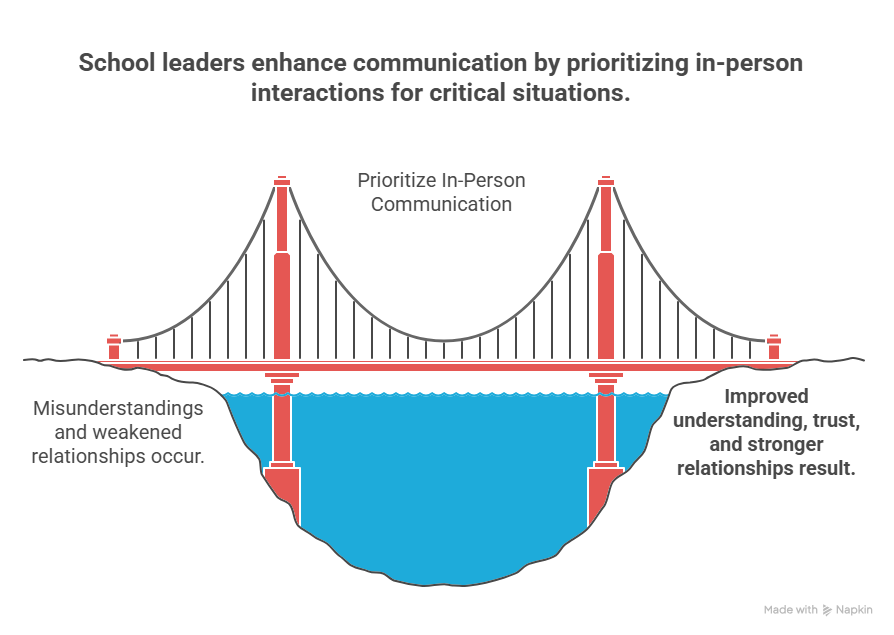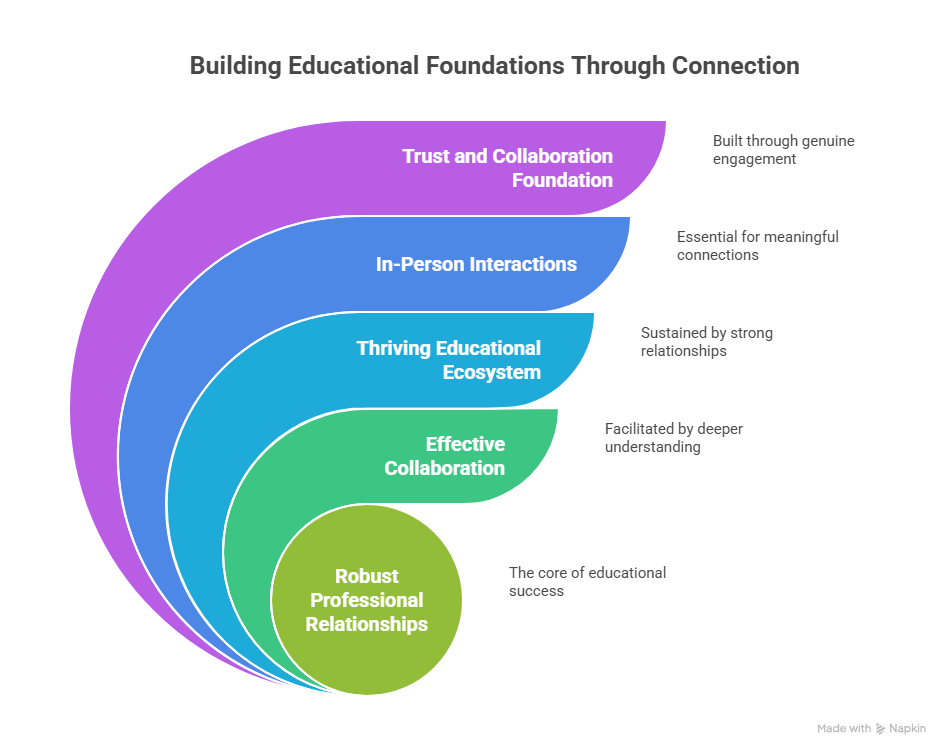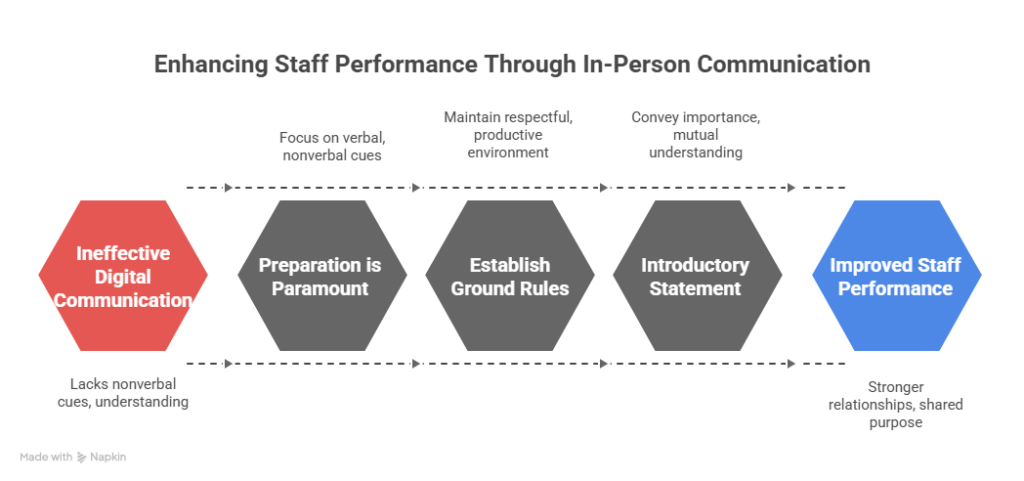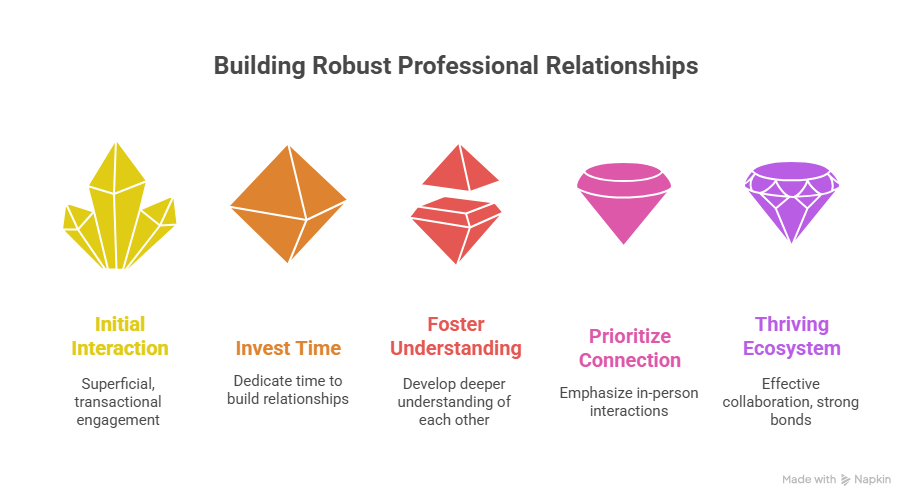GANDHINAGAR: In today’s digital age, school leaders must navigate the challenge of choosing the right communication tool for the job. While digital platforms offer efficiency and speed, they can’t replace the effectiveness of in-person communication. The most impactful leadership moments require a face-to-face conversation.
Effective communication is critical for success in any school or district. Discerning leaders recognize that not every message is suitable for a screen. For critical decisions, sensitive situations, or building strong relationships, the physical presence of leaders and educators is not just a preference, it’s a necessity.
The Strategic Choice: Beyond Digital Efficiency
The digital revolution has gifted us remarkable tools, transforming how we connect and share information with unprecedented speed. Yet, this convenience, while often efficient, does not inherently guarantee effectiveness.
Leaders must view every action and decision as a lever, pulled with intention to create the greatest possible impact. In this context, selecting the right communication tool for a particular situation becomes paramount. The allure of digital platforms, such as email, messaging apps, and even video conferencing, can lead to their overuse, often at the expense of genuine understanding and connection.
The fundamental limitation of purely digital interactions lies in their inability to fully convey the nuanced layers of human communication. Tone and body language are not merely supplementary elements; they are critical aspects of any conversation, telling a story and providing invaluable insight into how a message is being received.
Digital tools, particularly email or messaging platforms, simply cannot provide this crucial information. While video calls like Zoom offer some visual interaction, they frequently lack the depth and nuance of a true face-to-face discussion, making their use for significant interactions less ideal or appropriate primarily for long-distance scenarios.
This underscores the vital importance of intentionally choosing an in-person setting when the stakes are high, ensuring that communication extends beyond words on a screen to encompass the full spectrum of human expression and understanding.

The Threefold Mandate for Face-to-Face Interactions
To guide this strategic choice, a practical threefold rule of thumb exists for school leaders to determine when an in-person meeting is an absolute must, rather than a virtual one. If the answer is “yes” to even one of these three criteria, an in-person meeting is required to maximize impact and ensure genuine understanding.
A. When Critical Decisions Loom
Critical decisions demand dialogue that ensures messages are not just heard, but fully understood and absorbed. These moments often involve significant implications for departments, initiatives, or programs, requiring the collective and undistracted engagement of all participants. The in-person setting minimizes distractions that can plague virtual environments, promoting a shared focus and deeper comprehension of the magnitude of the decision being made.
The experience of important meetings held via online platforms, where participants were not fully engaged or failed to grasp the full implications, highlights the unique benefit of co-located presence.
Being on the same page, in the same physical space, resolves much of the potential for misinterpretation and fosters a collective sense of responsibility and understanding when navigating difficult choices. This direct engagement ensures that all parties are truly synchronized and committed to the chosen path, laying a stronger foundation for implementation and success.
B. Navigating Sensitive Situations
Sensitive situations, by their very nature, are fraught with potential for misunderstanding, anxiety, or emotional responses. Whether it’s addressing a delicate disciplinary matter, discussing a personal challenge, or resolving a conflict, the human element of empathy and immediate feedback is paramount.
In such contexts, body language provides critical, real-time insights into how the message is being received, offering cues that are entirely absent in text-based communications and significantly diminished in video calls. The ability to read facial expressions, observe posture, and detect subtle shifts in demeanor allows leaders to adjust their approach, offer reassurance, and ensure the message is delivered with the necessary care and compassion.
Without these nonverbal signals, a sensitive conversation can easily be misconstrued, leading to heightened anxiety or damage to professional relationships. An in-person meeting eliminates unnecessary guessing, reduces doubt, and allows for immediate clarification, fostering an environment of trust and reducing potential for negative interpretations.
C. Deliberate Relationship Building
Perhaps one of the most powerful reasons to prioritize in-person meetings is for the deliberate cultivation and strengthening of professional relationships. There is an inherent, irreplaceable power in physical presence that facilitates genuine human connection. In-person interactions are foundational for building trust, fostering empathy, and deepening professional bonds among colleagues.
While digital tools offer quick access, they can often be sterile, lacking the natural flow, spontaneous joy, and laughter that are hallmarks of authentic human connection. Education, fundamentally, is a people business, and individuals need to feel connected not only to their work but also to one another.
These connections, nurtured through shared space and direct interaction, are vital for creating a cohesive and supportive school environment. Whether the goal is to reinforce existing bonds or restore fractured relationships, the investment in face-to-face time yields significant returns in professional collaboration and team cohesion.

Performance Reviews: A Case for Presence
Performance reviews, irrespective of their specific nature—be it a formal evaluation, a celebration of achievement, or an intervention for growth—are inherently sensitive conversations that should be conducted in person.
Effective leaders understand that the success of these discussions hinges significantly on elements beyond spoken words, particularly tone and body language, which are critical aspects of any conversation. The objective is not merely to convey information but to facilitate a truly informative and transformational dialogue.
To achieve this, the setting must be conducive to candid conversation, productive dialogue, and the leader’s opportunity to ensure mutual understanding. This environment is best established through direct, in-person interaction, where both parties can fully engage and interpret all communication cues.
When inviting an educator to such a meeting, the language of the invitation itself can set a positive and productive tone, even before the conversation begins. An effective in-person invitation might sound like this: “Jim, I’d like to meet in person because I want to provide ample time to have a productive conversation regarding your performance.
I value your thoughts on how you think you are doing and areas where you see yourself growing. Let’s take time to explore what’s going well and how we can identify areas of focus moving forward”. Such a direct, face-to-face invitation, perhaps a quick drop-in, immediately eliminates any guessing or unnecessary anxiety on the part of the employee, allowing them to ask clarifying questions on the spot. This immediacy and transparency are rarely fully achieved through email or a phone call, which can leave room for apprehension.
Performance reviews serve as perfect opportunities to identify both strengths and areas for growth. Given their delicate nature, adhering to a sound framework is imperative to guide the conversation effectively:
- Start with the specific area of focus: Clearly articulate the subject of the discussion to ensure clarity and purpose.
- Provide details for why this particular area is being identified: Offer concrete examples and context to support the feedback.
- Offer information about how this positively or negatively impacts their students and the school: Connect the individual’s performance directly to the broader educational mission and community, emphasizing collective impact.
- End with a final statement that concretely concludes your point: Provide a clear summary or next steps to ensure the message is fully absorbed and understood.
Regardless of the formality of the conversation or the position of the individual, improving and celebrating staff performance is essential to the health of the school community. Committing to conduct these conversations in person, by taking the time to connect one-on-one, significantly enhances the effectiveness and impact of the leader’s message.
Ultimately, performance discussions are not merely about evaluation; they are sensitive issues that present crucial opportunities to strengthen professional relationships, fostering a sense of support and shared purpose.

Navigating Tough Conversations with Intention
Tough conversations are an inevitable part of leadership, and their successful navigation is crucial for maintaining a healthy and productive school environment. These critical discussions fundamentally require robust dialogue to ensure that the message is not only heard but deeply understood, all while preserving the professional relationship between parties.
Preparation for such meetings is paramount, with school leaders needing to meticulously focus on both the verbal content and the nonverbal communication signals. Body language, in particular, offers a silent narrative, providing invaluable insight into how the message is being received, allowing leaders to gauge reactions and adjust their approach in real-time.
The limitations of digital tools become glaringly apparent in these high-stakes scenarios. Email or messaging platforms, for instance, are completely devoid of this critical nonverbal information, leaving significant gaps in understanding. Even video conferencing tools like Zoom, while offering some visual connection, frequently fall short in capturing the full depth and nuance of a face-to-face interaction, thus making them less ideal for tough conversations, unless distance necessitates their use.
An introductory statement for a challenging discussion should explicitly convey the importance of the in-person setting and the leader’s commitment to mutual understanding. For example: “Team, this is a tough discussion we need to have, and I wanted to make sure we talk about it face-to-face so that we fully understand each other. I realize that you may not agree with everything I am going to say, but I value each of your perspectives and need to hear your thoughts”. This sets a tone of transparency and respect, inviting open dialogue even on difficult subjects.
Crucially, establishing ground rules before engaging in tough conversations is essential for maintaining a productive and respectful environment:
- “Let’s agree to listen intently so that we understand what everyone is saying.” This rule emphasizes active listening, ensuring that each participant genuinely processes the information being shared, rather than merely waiting to respond.
- “Let’s agree to listen with respect and assume positive intent.” This encourages empathy and minimizes defensiveness, fostering an atmosphere where ideas can be discussed constructively, even when there is disagreement.
- “Let’s agree to keep this conversation about necessary actions and outcomes, not about one another.” This vital rule shifts the focus from personal attacks or blame to problem-solving and collective responsibility, ensuring that the dialogue remains productive and goal-oriented.
Tough conversations also encompass instances where difficult decisions must be made, ranging from budget cuts to crucial strategy meetings. The more challenging the conversation or decision, the more critical it is to hold it in an in-person setting.
Past experiences have shown that highly important meetings conducted virtually often result in participants being less engaged or failing to fully grasp the profound magnitude of decisions impacting their departments or programs.
Being physically present together resolves many potential distractions and significantly promotes comprehension when facing the most arduous challenges, ensuring that everyone is genuinely on the same page and committed to the path forward.
Cultivating Connection: The Art of Relationship Building
Beyond addressing performance or navigating difficulties, face-to-face meetings offer an unparalleled opportunity for the fundamental, ongoing work of relationship building. Whether the aim is to strengthen an already positive relationship or to embark on the delicate process of restoring one, the power of being physically present with colleagues is immense and transformative.
In-person interactions are foundational for fostering trust, cultivating authentic human connectivity, increasing empathy among team members, and ultimately deepening professional bonds within the educational community. These intangible yet critical benefits are the lifeblood of a cohesive and supportive school environment.
When initiating a meeting solely for the purpose of relationship building, the invitation itself should reflect this open and supportive intent. An effective phrasing might be: “Linda, I would like to meet in person to have a good understanding about how things are going for you, essentially what’s working and what’s not.
Please know that we have these one-on-one meetings with staff just to check in. There’s no formal agenda—it’s just an opportunity to talk”. This approach signals genuine care and creates a low-pressure environment conducive to honest sharing.
To maximize the productivity and benefit of these relationship-focused dialogues, a clear framework should guide the interaction:
- Be present—no phones and no computers: Eliminating digital distractions ensures full attention and signals respect for the individual and the conversation. This dedicated presence fosters a sense of being truly heard and valued.
- Be curious—ask questions: Genuine curiosity encourages deeper understanding of the colleague’s perspective, challenges, and successes. Asking open-ended questions demonstrates interest and facilitates more comprehensive sharing.
- Be vulnerable—don’t get defensive: Leadership requires a willingness to be open and acknowledge one’s own limitations or areas for growth. Avoiding defensiveness creates a safe space for others to be vulnerable in return, fostering mutual trust.
- Be transparent—share thoughts and ideas: Openly sharing thoughts and ideas, even if unformed, promotes authenticity and a sense of partnership. This transparency helps build rapport and demonstrates a willingness to engage openly.
Ultimately, whether engaging with a new team member just starting their journey or a seasoned veteran who has dedicated years to the school, there is simply no substitute for investing the time to build a robust professional relationship. These direct, human connections facilitate a deeper understanding of one another, which is essential for effective collaboration and a thriving educational ecosystem. They move beyond the transactional nature of tasks and foster the relational glue that holds a successful school community together.

Prioritizing Connection to Maximize Benefits of One-on-One Meetings
The digital revolution has brought undeniable advantages, particularly in terms of quick access to information and people. However, this convenience often comes at the cost of genuine human connection, leading to interactions that can feel sterile and devoid of the natural flow, joy, and laughter that spontaneously arise during in-person meetings. Education is fundamentally a people business, a field where individuals thrive when they feel deeply connected to their work and, critically, to one another.
While there is undoubtedly a legitimate place for virtual tools as methods of communication—and indeed, their strategic use can develop leaders’ communication skills—their utility is not universal. When it comes to the most impactful and sensitive aspects of leadership—making critical decisions, navigating delicate conversations, and building enduring relationships—nothing supersedes the profound need for an in-person connection.
These are the moments when the full spectrum of human communication—verbal, nonverbal, emotional—must be engaged to ensure clarity, understanding, empathy, and the strengthening of the vital bonds that underpin a successful educational environment. Leaders who intentionally prioritize these face-to-face interactions are not just communicating; they are building the very foundation of trust and collaboration that propels schools forward.


